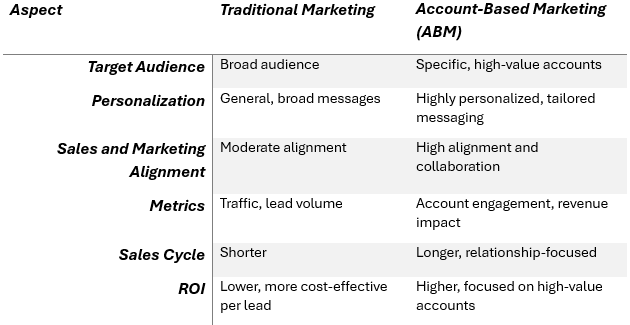Traditional marketing and account-based marketing (ABM) are two distinct approaches to reaching customers, each with its own strategies, goals, and target audiences. Here’s a breakdown of the main differences between the two:
Targeting Approach
Traditional Marketing: Traditional marketing takes a broad approach to reach as many potential customers as possible. It’s generally designed to attract a wide audience and generate a high volume of leads. This method often focuses on attracting people who fit a general target demographic and may result in a high volume of unqualified leads.
Account-Based Marketing (ABM): ABM is a highly targeted, strategic approach that focuses on specific high-value accounts or companies. Instead of casting a wide net, ABM involves identifying key accounts that are most likely to benefit from the product or service, then tailoring all marketing efforts toward engaging those specific accounts.
Personalization and Messaging
Traditional Marketing: Messages in traditional marketing tend to be broad and are designed to appeal to a large audience. While there may be some segmentation (e.g., by industry or job role), messaging is generally not deeply personalized for each individual prospect or company.
ABM: ABM is rooted in personalization. Marketing and sales teams collaborate to craft customized messages and campaigns that resonate with the specific needs, challenges, and goals of individual accounts. This level of personalization often includes tailoring messaging to multiple stakeholders within a target company.
Alignment Between Sales and Marketing
Traditional Marketing: Sales and marketing in traditional approaches often operate somewhat independently. Marketing generates leads through campaigns, which are then handed off to sales. This division can sometimes result in a misalignment between the types of leads generated and the needs of the sales team.
ABM: ABM requires close collaboration between marketing and sales. Both teams work together to select target accounts, align on strategy, and jointly track progress. This alignment helps ensure that all efforts are focused on driving engagement and conversions with high-value accounts, making the sales process more efficient.
Measurement and Metrics
Traditional Marketing: In traditional marketing, metrics like website traffic, lead volume, and conversion rates are commonly tracked. Success is often measured in terms of the quantity of leads generated rather than their quality or fit with the sales team’s priorities.
ABM: ABM focuses on metrics that reflect engagement and progress with specific accounts, such as account penetration, engagement level, and revenue generated from target accounts. Success is typically measured by the strength and depth of relationships within each account, conversion rate within those accounts, and overall revenue impact.
Sales Cycle and Relationship Building
Traditional Marketing: Traditional marketing often has a shorter sales cycle since it aims to cast a wide net and drive as many conversions as possible, with less focus on building long-term relationships.
ABM: ABM involves longer, more consultative sales cycles and emphasizes relationship building within each target account. This approach is particularly suited for high-value B2B sales, where decision-making involves multiple stakeholders, and building trust is essential for closing deals.
ROI and Cost Efficiency
Traditional Marketing: Traditional marketing is generally more cost-effective on a per-lead basis, especially when targeting a large audience. However, the return on investment can be lower since not all leads may be a good fit.
ABM: ABM can be more resource-intensive, with costs focused on targeting and engaging a smaller group of high-value accounts. However, because it is focused on accounts that are more likely to convert, ABM often delivers a higher return on investment, especially for companies with a clear profile of ideal high-value clients.

When to Use Each Approach
Traditional Marketing: Best suited for businesses with a large potential market or lower-cost products/services that don’t require deep relationship-building. It’s ideal for companies looking to build broad brand awareness and generate a high volume of leads.
ABM: Works best for B2B companies, especially those with complex, high-value products or services, where sales require deep engagement and multiple decision-makers. ABM is particularly effective for industries with a limited number of potential high-value clients, such as enterprise software, manufacturing solutions, or professional services.
Finding the Middle Ground: A Hybrid Marketing Approach
While traditional marketing and account-based marketing (ABM) have distinct strengths, many businesses find that a hybrid approach can be the most effective way to reach their goals. This middle ground combines the broad reach of traditional marketing with the precision and personalization of ABM. By utilizing traditional marketing tactics such as brand awareness and broad lead generation, companies can build a wide funnel of potential interest. At the same time, selectively applying ABM strategies to high-value accounts within that funnel allows for deeper engagement and personalized outreach. This balanced approach helps companies efficiently manage resources, create a scalable marketing strategy, and optimize ROI by leveraging both broad targeting and personalized, high-touch engagement.
If you want to know more about traditional marketing, account-based marketing, or a combination of the two, call Buckaroo Marketing today!






